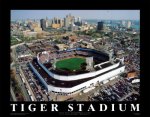 Plans to save Old Tiger Stadium–the Tigers moved to Comerica Park in 1999–have slowly declined in scale and ambition. But the Old Tiger Stadium Conservancy, with the help of long-time Tiger broadcaster Ernie Harwell, is still fighting to preserve one wall of the Stadium, from dugout to dugout, as a nod to the history of the site. The City last week issued a reprieve to the group, giving them a few more months to raise the $15 million price tag of that preservation plan. Detroit may be able to find a balance here between making way for needed new development, and being grounded in a proud history. But it will unfortunately just come down to that $15 million, to be raised by a group for whom I can’t find a website.
Plans to save Old Tiger Stadium–the Tigers moved to Comerica Park in 1999–have slowly declined in scale and ambition. But the Old Tiger Stadium Conservancy, with the help of long-time Tiger broadcaster Ernie Harwell, is still fighting to preserve one wall of the Stadium, from dugout to dugout, as a nod to the history of the site. The City last week issued a reprieve to the group, giving them a few more months to raise the $15 million price tag of that preservation plan. Detroit may be able to find a balance here between making way for needed new development, and being grounded in a proud history. But it will unfortunately just come down to that $15 million, to be raised by a group for whom I can’t find a website.
Pat Clark in Pittsburgh forwarded this poignant photo testimonial to the old ballpark. There is something inefficient and about the way we are willing to pave over this history, in desperation for the next silver bullet development. I know we need the revenue, but I can’t help but think there’s a more creative solution.
I’m also struck by how little coverage this is getting in Detroit, perhaps due to issue fatigue? (Compare the Freep article linked above to this New York Times article from a month ago.) I’m struck by the closing sentence, a quote from Timothy McKay, head of the Greater Corktown Development Corporation. “This is an old city. But history here is discounted by a lot of people.”
Our history’s not all roses, but back me up–how can we know where we’re going if we don’t remember from where we came?




You must be logged in to post a comment.